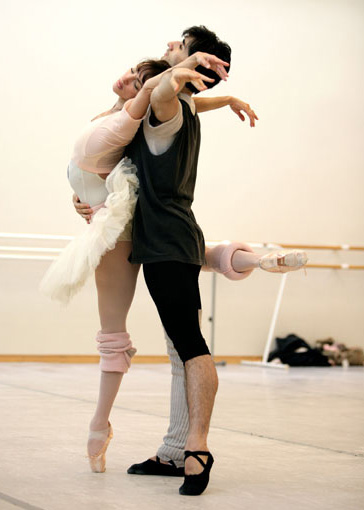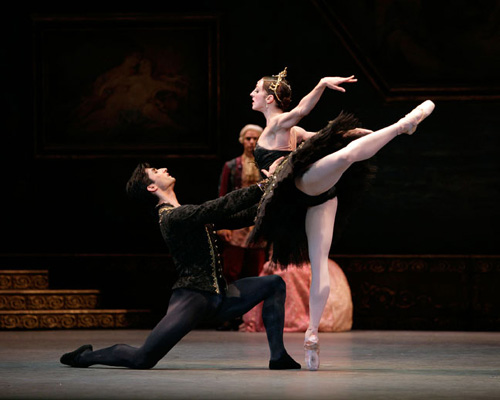|
Good journalism is famous for creating cultural appetites. The writing, in this magazine, about prima ballerina Lorena Feijoo was a case in point for me. Catherine Honig's interview and her musings about the outstanding qualities of this Cuban dancer in the June and July issue of Scene4 Magazine gave me pause. I had yet to discover this dancer. Would I be convinced? My first chance came last season and was inconclusive – the piece was brief and the odds were stacked too much in her favor. Lorena was dancing Val Caliparoli's "Lambarena," a choreography tailored to her body, fast, sexy, virtuosic, and she tossed it off with such natural bravura and glee, as if to say, listen, folks, this is Cuban dance and guess what? I am a Cuban dancer.
But how would the saucy Cuban dancer stand up to a classical challenge like Swan Lake? To a role that demands acting, delicacy, archetypal femininity? With that strong back of hers (that was the focus of "Lambarena"), would she be convincing as a swan – this most ethereal creature of the ballet stage?
The answer is yes – and something more than yes. In Helgi Tomasson's renewal of his 1988 Swan Lake for the San Francisco Ballet, Lorena was not the transparent Swan Queen of old. She brought the thrill of something entirely new and different to the role. I am tempted to call it power – almost in the same lineage as Adam Cooper's sensational swan in Matthew Bourne's "all-mal" Swan Lake. Bourne's choreography brought home for the first time ever that swans aren't necessarily the dainty, weightless feather-elves we are used to in ballet, a breed of fainting flowers, floating an inch above ground. Lorena's swan is an embodied creature, and her grace is rooted in strength. Instead of projecting evanescence, this Queen of Swans projects both the tragedy of being forced under a spell and the royal pride of her original station. The Prince meets his equal in bird-shape, a force of purity and nobility, and at the same time her creature-innocence seems to make her doubly vulnerable to the human man and his human destiny. The tremor with which Lorena's Swan meets the man is very touching; the little battement beats of her legs seem to speak through her entire body. She reinvents details in movements like the small flat-footed hop in a low arabesque that is the signature move of the swans: she executes the hop on demi-pointe, evoking the strange delicacy of a bird. The utter technical precision and economy of her dancing withholds as much as it gives moment by moment, with subtly controlled ritardandos, time-stopping balances on point, and sudden outbursts of energy in high-legged leaps or pirouettes that seem to melt back into a caress of wings.

In Lorena's dancing it becomes clear what sets a truly great dancer apart: the same phenomenon that marks a great singer: phrasing. It is not the long, astronomically high legs nor the extraordinarily curved, expressive feet, nor the reed-like neck, nor the fragile waist. Lorena Feijoo does not possess any of these attributes, and yet she puts her unremarkably lovely body to remarkable use through her phrasing. Which is another way to say, her musicality. True dancing comes from inside, from some invisible center of energy. In Lorena's case, this energy, paired with technical perfection, is such that her on-pointe balances acquire something akin to the male "ballon," the energy at the top of a high leap that seems to hold the body floating-on-air, suspended in space.
Most unusual are Lorena's arms and hands. Not only undulating, as one expects in this ballet; flexible, as if they had more articulations than human arms, they seem to end in hands that can only be described as feathered. Instead of the classically graceful, predictable ballet hand, Lorena lets her fingers float apart as if spread by air currants – a most surprisingly beautiful swan-like effect. In her glittering whiteness, this Swan Queen ("Odette") is burning with a subdued, smoldering, almost hidden fire that projects both a yearning and a sense of surrender because the black magic renders her ultimately powerless.
None of this in Act III, when she appears as the treacherous Black Swan, "Odile." Now she is a bird of prey, a raptor – and the marked deceit in her acting and movement, paired with knife-sharp turns, fouettés and mid-air balances brought the house down. The smoldering fire of the innocent Odette now is a cold and lethal weapon. Lorena's Black Swan appeared at moments unable to wait for the music, drawing the orchestra along with her as if to say, come on, faster, faster, this is intense!

The most thrilling moment, however, came after the bravura. When a vision of the true White Swan has pierced the Prince's conscience, the Black Swan puts on her imitation of Odette in order to nail the betrayal. Tchaikovsky's haunting White Swan music seemed to transform Lorena in a breathtakingly perverse rendition of her former self, determined to wipe out the Prince's memory of Odette with a sensuous, nostalgic lie.
I have never before seen a truly convincing Black Swan – especially not from any of the great and truly romantic dancers of the past. Their overly feminine inclination certainly made them perfect White Swans, too perfect to master the shift to evil. More recent incarnations have sometimes pushed the role too far, beyond the fine line between character and caricature. One of the available DVDs – the Kirov's Swan Lake – is a case in point: prima ballerina Galina Mezentseva acts with a stereotypical, sarcastically pinched grin that makes one wonder what sort of a dunce would be fooled by her. Lorena Feijoo is not only very subtle in her acting; she remains appealing and fascinating enough to make Odile's victory convincing. With her more androgynous, more powerfully energized dancing, she broke new ground by giving Odette/Odile, this old classic role of roles, a timeless psychological truth.
Now to the Prince. A new acquisition of San Francisco Ballet, the handsome young Armenian dancer Davit Karapetyan. brings a lot to the role. Beautifully proportioned, with long, exquisite legs, he displayed an impressive technique: his double-tours landed him each time in a picture-book fifth position; his leaps were high and suspended, his landings in a one-legged plié smooth and noiseless. His connecting moves and even his simple walking showed an unusual, graceful fluidity. His partnering and bearing could not have been more naturally noble. And yet, there was a marked lack of passion or urgency in his way of dancing. Instead of being a Prince in the grip of an immortal love obsession, Karapetyan often seemed like a deer in the headlights, a yearling with the air of anxious astonishment about what was happening to him. One could argue that any young boy, faced with Lorena's elementary power, might be astonished, to say the least. But the beauty of his dancing and his air of sensitivity provided a good-enough foil for his Swan Queen to shine. I think we will have to wait a season or two for Davit Karapetyan to unthaw and come out of his emotional isolation. He is undoubtedly a great dancer in the making.
|